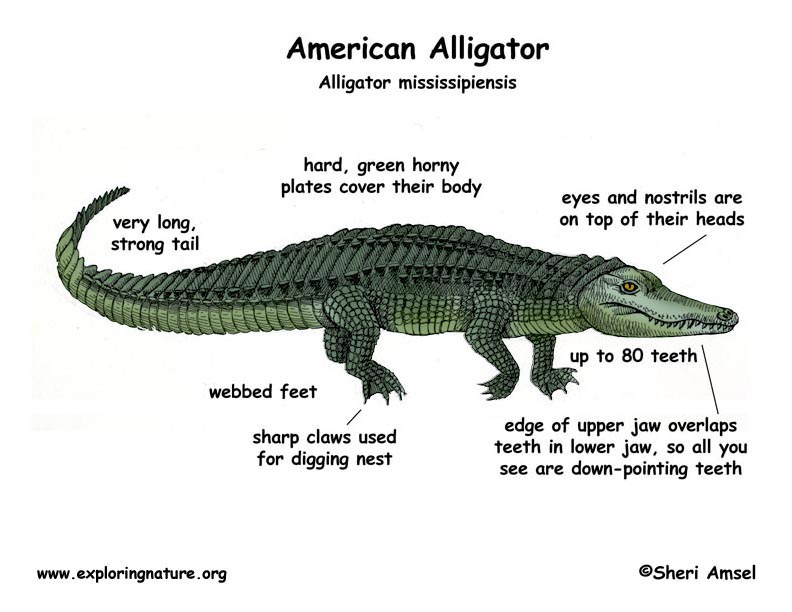

They are found in the Southeastern U.S. through Texas.
They live in freshwater swamps, marshes, rivers, lakes and ponds. They can’t live in salt water, but can stand a little salty water for a short time, so are sometimes found where salt water mixes with freshwater (brackish water) in mangrove swamps.
They can reach up to 15 feet long, but most adults are no more than 10 feet long. Females are smaller. When their mouth is closed, the edge of their upper jaw overlaps the teeth in the lower jaw, so all you see are down-pointing teeth. In crocodiles you can also see bottom teeth pointing up, which is how you can tell them apart. They can have up to 80 teeth. Their eyes and nostrils are on top of their heads so they can be almost all under the water and still be able to see, smell and breathe.
They build burrows to sleep in during cold weather. They need to have water to live in, so during very dry times it is not unheard of for an alligator to show up in someone’s swimming pool. They do not chew their food, but use teeth to tear off big chunks of meat and swallow them whole.
Young alligators eat insects, fish and frogs. Adults feed on fish, turtles, small mammals, birds, reptiles and even dead and rotting meat (carrion). They will take household pets and have sometimes attacked humans. If it gets colder than 65° they stop hunting.
Adult alligator’s only predator is man. Young alligators are eaten by raccoons, large fish, birds and other alligators.
Alligators build a nest out of a pile of torn up plants and mud in the early summer up on the bank above the river or lake in which they live. The female lays 20 - 50 eggs. Then to protect the eggs, she covers the opening to the nest with plants. When the eggs start to hatch, the babies make calls that she hears and she opens the nest back up. If something happens to the mother before the babies hatch, they never make it out of the nest. When the babies come out of the nest, she carries them, a few at a time, in her mouth down to the water. Baby alligators will form little groups (pods) and stay near their mother for a few months to a couple of years for protection against predators.
Kingdom: Animalia
Phylum: Chordata
Subphylum: Vertebrata
Class: Reptilia
Order: Crocodylia
Family: Crocodylidae
Subfamily: Alligatorinae
Genus: Alligator
Species: A. mississippiensis
When you research information you must cite the reference. Citing for websites is different from citing from books, magazines and periodicals. The style of citing shown here is from the MLA Style Citations (Modern Language Association).
When citing a WEBSITE the general format is as follows.
Author Last Name, First Name(s). "Title: Subtitle of Part of Web Page, if appropriate." Title: Subtitle: Section of Page if appropriate. Sponsoring/Publishing Agency, If Given. Additional significant descriptive information. Date of Electronic Publication or other Date, such as Last Updated. Day Month Year of access < URL >.
Amsel, Sheri. "Alligator (American)" Exploring Nature Educational Resource ©2005-2024. December 13, 2024
< http://www.exploringnature.org/db/view/503 >

